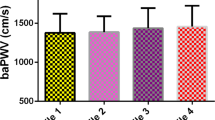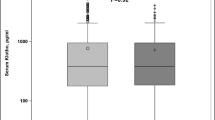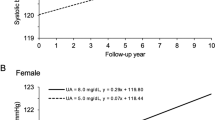Abstract
Data from a cross-sectional population-based study carried out in the town of Bollate (Milan) were used to verify whether there is an age-modulated relationship between the components of blood pressure (BP) and plasma uric acid and fibrinogen levels. Changes in uric acid and fibrinogen levels in relation to diastolic BP (DBP), systolic BP (SBP), mean arterial pressure (MAP) and pulse pressure (PP) in 820 subjects aged 42–59 years and in 509 subjects aged 60–74 years were estimated from general linear models adjusted by the clinical, lifestyle and biological variables traditionally associated with cardiovascular risk. Uric acid levels significantly increased with DBP and MAP only in the middle-aged group without metabolic syndrome or diabetes, and were even in those who were pre-hypertensive. On the contrary, fibrinogen levels significantly increased with SBP and PP only among the elderly with metabolic syndrome or diabetes, and were particularly high among those with stage 2 hypertension. These findings add evidence concerning an age-modulated relationship between the levels of uric acid and fibrinogen and the steady and pulsatile components of BP and it is possibly related to the different mechanisms underlying increased BP: renal factors in middle-aged subjects and vascular abnormalities in the elderly.
This is a preview of subscription content, access via your institution
Access options
Subscribe to this journal
Receive 12 digital issues and online access to articles
$119.00 per year
only $9.92 per issue
Buy this article
- Purchase on Springer Link
- Instant access to full article PDF
Prices may be subject to local taxes which are calculated during checkout
Similar content being viewed by others
References
Lewington S, Clarke R, Qizilbash N, Pero R, Collins R, Prospective Studies Collaboration. Age-specific relevance of usual blood pressure to vascular mortality: a meta-analysis of individual data for one million adults in 61 prospective studies. Lancet 2002; 360: 1903–1913.
Franklin SS, Larson MG, Khan SA, Wong ND, Leip EP, Kannel WB et al. Does the relation of blood pressure to coronary heart disease risk change with aging? The Framingham Heart Study. Circulation 2001; 103: 1245–1249.
Darne B, Girerd X, Safar M, Cambien F, Guize L . Pulsatile versus steady component of blood pressure: a cross-sectional analysis and a prospective analysis on cardiovascular mortalily. Hypertension 1989; 13: 392–400.
Franklin SS, Gustin W, Wong ND, Larson MG, Weber MA, Kannel WB et al. Hemodynamic patterns of age-related changes in blood pressure. The Framingham Heart Study. Circulation 1997; 96: 308–315.
Feig DI, Kang D-H, Johnson RJ . Uric acid and cardiovascular risk. N Engl J Med 2008; 359: 1811–1821.
Koenig W . Fibrin(ogen) in cardiovascular disease: an update. Thromb Haemost 2003; 89: 601–609.
Kosugi T, Nakagawa T, Kamath D, Johnson RJ . Uric acid and hypertension: an age-related relationship? J Hum Hypertens 2009; 23: 75–76.
Lu Z, Dong B, Wu H, Chen T, Zhang Y, Wu J et al. Serum uric acid level in primary hypertension among Chinese nonagenarians/centenarians. J Hum Hypertens 2009; 23: 113–121.
Forman JP, Choi H, Curhan GC . Plasma uric acid level and risk for incident hypertension among men. J Am Soc Nephrol 2007; 18: 287–292.
Shankar A, Wang JJ, Rochtchina E, Mitchell P . Positive association between plasma fibrinogen level and incident hypertension among men. Hypertension 2006; 48: 1043–1049.
Marques-Vidal P, Cambou J-P, Bongard V, Ruidavets J-B, Ferrières J . Systolic and diastolic hypertension: no relationship with lipid and inflammatory markers in Haute-garonne, France. Am J Hypertens 2003; 16: 681–684.
Junker R, Heinrich J, Schulte H, Erren M, Assmann G . Hemostasis in normotensive and hypertensive men: results of the PROCAM study. The prospective cardiovascular Munster study. J Hypertens 1998; 16: 913–916.
Stefanick ML, Legault C, Tracy RP, Howard G, Craig MK, Lucas DL et al. Distribution and correlates of plasma fibrinogen in middle-aged women. Arterioscler Thromb Vasc Biol 1995; 15: 2085–2093.
Nicolosi A . Le indagini di popolazione sulla prevalenza delle principali malattie oculari in Italia. In: Cerulli L, Miglior M, Ponte F (eds). L’epidemiologia oftalmica in Italia. INC: Roma, 1997, pp 43–70.
Leite MLC, Nicolosi A . Lifestyle correlates of anthropometric estimates of body adiposity in an Italian middle-aged and elderly population: a covariance analysis. Int J Obes 2006; 30: 926–934.
Alberti KG, Zimmet P, Shaw J, IDF epidemiology task force consensus group. The metabolic syndrome—a new worldwide definition. Lancet 2005; 366: 1059–1062.
Chobanian AV, Bakris GL, Black HR, Cushman WC, Green LA, Izzo JL, et al., National Heart, Lung, and Blood Institute Joint National Committee on Prevention, Detection, Evaluation, and Treatment of High Blood Pressure; National High Blood Pressure Education Program Coordinating Committee. The Seventh Report of the Joint National Committee on Prevention, Detection, Evaluation, and Treatment of High Blood Pressure. The JNC 7 report. JAMA 2003; 289: 2560–2572.
Levey AS, Bosch JP, Lewis JB, Greene T, Rogers N, Roth D . A more accurate method to estimate glomerular filtration rate from serum creatinine: a new prediction equation: Modification of Diet in Renal Disease study group. Ann Intern Med 1999; 130: 461–470.
Levey AS, Greene T, Kusek JW, Beck G . A simplified equation to predict glomerular filtration rate from serum creatinine. J Am Soc Nephrol 2000; 11 (abstract A0828).
McCullagh P, Nelder JA . Generalized Linear Models, 2nd edn. Chapman & Hall: London, 1989.
Verdecchia P, Angeli F . Natural history of hypertension subtypes. Circulation 2005; 111: 1094–1096.
Khattar RS, Swales JD, Dore C, Senior R, Lahiri A . Effect of aging on the prognostic significance of ambulatory systolic, diastolic, and pulse pressure in essential hypertension. Circulation 2001; 104: 783–789.
Cigolini M, Targher G, Tonoli M, Manara F, Muggeo M, De Sandre G . Hyperuricaemia: relationships to body fat distribution and other components of the insulin resistance syndrome in 38-year-old healthy men and women. Int J Obes Relat Metab Disord 1995; 19: 92–96.
Chu NF, Wang DJ, Liou SH, Shieh SM . Relationship between hyperuricemia and other cardiovascular disease risk factors among adult males in Taiwan. Eur J Epidemiol 2000; 16: 13–17.
Brand FN, McGee DL, Kannel WB, Stokes III J, Castelli WP . Hyperuricemia as a risk factor of coronary heart disease: The Framingham Study. Am J Epidemiol 1985; 121: 11–18.
Yeh CJ, Pan WH, Jong YS, Kuo YY, Lo CH . Incidence and predictors of isolated systolic hypertension and isolated diastolic hypertension in Taiwan. J Formos Med Assoc 2001; 100: 668–675.
Syamala S, Li J, Shankar A . Association between serum uric acid and prehypertension among US adults. J Hypertens 2007; 25: 1583–1589.
Johnson RJ, Feig DI, Herrera-Acosta J, Kang DH . Resurrection of uric acid as a causal risk factor in essential hypertension. Hypertension 2005; 45: 18–20.
Shankar A, Klein R, Klein BEK, Nieto FJ . The association between serum uric acid level and long-term incidence of hypertension: population-based cohort study. J Hum Hypertens 2006; 20: 937–945.
Perlstein TS, Gumieniak O, Williams GH, Sparrow D, Vokonas PS, Gaziano M et al. Uric acid and the development of hypertension. The Normative Aging Study. Hypertension 2006; 48: 1031–1036.
Krishnan E, Kwoh CK, Schumacher HR, Kuller L . Hyperuricemia and incidence of hypertension among men without metabolic syndrome. Hypertension 2007; 49: 298–303.
Johnson RJ, Rodriguez-Iturbe B, Kang DH, Feig DI, Herrera-Acosta J . A unifying pathway for essential hypertension. Am J Hypertens 2005; 18: 431–440.
Mazzali M, Hughes J, Kim YG, Jefferson JA, Kang D-H, Gordon KL et al. Elevated uric acid increases blood pressure in the rat by a novel crystal-independent mechanism. Hypertension 2001; 38: 1101–1106.
Khosla UM, Zharikov S, Finch JL, Nakagawa T, Roncal C, Mu W et al. Hyperuricemia induces endothelial dysfunction. Kidney Int 2005; 67: 1739–1742.
Mercuro G, Vitale C, Cerquetani E, Zoncu S, Deidda M, Fini M et al. Effect of hyperuricemia upon endothelial function in patients at increased cardiovascular risk. Am J Cardiol 2004; 94: 932–935.
Perlstein TS, Gumieniak O, Hopkins PN, Murphey LJ, Brown NJ, Williams GH et al. Uric acid and the state of the intrarenal renin-angiotensin system in humans. Kidney Int 2004; 66: 1465–1470.
Watanabe S, Kang DH, Feng L, Nakagawa T, Kanellis J, Lan H et al. Uric acid, hominoid evolution, and the pathogenesis of salt-sensitivity. Hypertension 2002; 40: 355–360.
Blacher J, Safar M . Specific aspects of high blood pressure in the elderly. J Renin Angiotensin Aldosterone Syst 2002; 3 (suppl 1): S8–S13.
Witteman JCM, Grobbee DE, Walkenburg HA, Burger H, Hofman A, van Hemert AM . J-shaped relation between change in diastolic blood pressure and progression of aortic atherosclerosis. Lancet 1994; 343: 504–507.
Ross R . Atherosclerosis—an inflammatory disease. N Engl J Med 1999; 340: 115–126.
Hansson GK . Inflammation, atherosclerosis, and coronary artery disease. N Engl J Med 2005; 352: 1685–1695.
McEniery CM, Wilkinson IB . Large artery stiffness and inflammation. J Hum Hypertens 2005; 19: 507–509.
Wakabayashi I, Masuda H . Association of acute-phase reactants with arterial stiffness in patients with type 2 diabetes mellitus. Clin Chim Acta 2006; 365: 230–235.
Duprez DA, Somasundaram PE, Sigurdsson G, Hoke L, Florea N, Cohn JN . Relationship between C-reactive protein and arterial stiffness in an asymptomatic population. J Hum Hypertens 2005; 19: 515–519.
Vlachopoulos C, Pietri P, Aznaouridis K, Vyssoulis G, Vasiliadou C, Bratsas A et al. Relationship of fibrinogen with arterial stiffness and wave reflections. J Hypertens 2007; 25: 2110–2116.
Ciuffetti G, Schillaci G, Lombardini R, Pirro M, Vaudo G, Mannarino E . Plasma viscosity in isolated systolic hypertension: the role of pulse pressure. Am J Hypertens 2005; 18: 1005–1008.
Safar ME, Thomas F, Blacher J, Nzietchueng R, Bureau J-M, Pannier B et al. Metabolic syndrome and age-related progression of aortic stiffness. J Am Coll Cardiol 2006; 47: 72–75.
De Silva DA, Woon F-P, Gan H-Y, Cameron J, Kingwell B, Koh T-H et al. Arterial stiffness, metabolic syndrome and inflammation amongst Asian ischaemic stroke patients. Eur J Neurol 2008; 15: 872–875.
Roman MJ, Ganau A, Saba PS, Pini R, Pickering TG, Devereux RB . Impact of arterial stiffening on left ventricular structure. Hypertension 2000; 36: 489–494.
Zhu Y, Zhang F, Zhang F-C, Wang G, Zhou L . Risk factors related to left ventricular hypertrophy in elderly hypertensive patients. J Chin Clin Med 2006; 1: 308–313.
Palmieri V, Tracy RP, Roman MJ, Liu JE, Best LG, Bella JN et al. Relation of left ventricular hypertrophy to inflammation and albuminuria in adults with type 2 diabetes: the strong heart study. Diabetes Care 2003; 26: 2764–2769.
Feig DI, Kang D-H, Nakagawa T, Mazzali M, Johnson RJ . Uric acid and hypertension. Curr Hypertens Rep 2006; 8: 111–115.
Acknowledgements
The original survey on which the present article is based on was supported by research programme grant funding from the Italian National Research Council in the framework of the project Prevention and Control of Disease Factors (FATMA).
Author information
Authors and Affiliations
Corresponding author
Ethics declarations
Competing interests
The author declares no conflict of interest.
Rights and permissions
About this article
Cite this article
Leite, M. Uric acid and fibrinogen: age-modulated relationships with blood pressure components. J Hum Hypertens 25, 476–483 (2011). https://doi.org/10.1038/jhh.2010.89
Received:
Revised:
Accepted:
Published:
Issue Date:
DOI: https://doi.org/10.1038/jhh.2010.89
Keywords
This article is cited by
-
Asymptomatic hyperuricemia: is it time to intervene?
Clinical Rheumatology (2017)
-
Uric Acid is an Important Predictor for Hypertensive Early Atherosclerosis
Advances in Therapy (2012)



